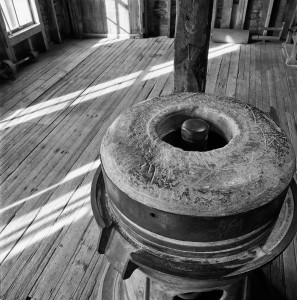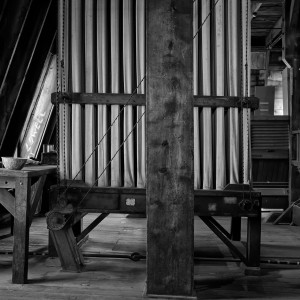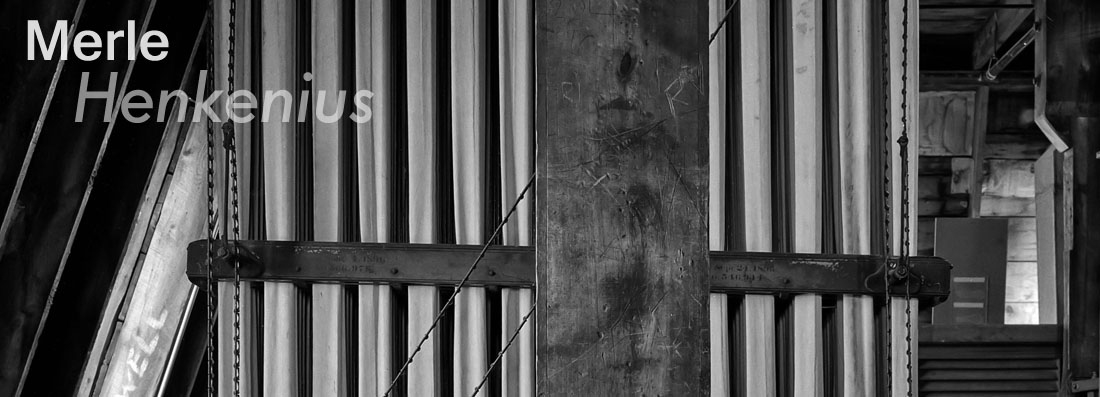page 2 of 20
In my teens, I sought Neligh’s other riches: English Leather aftershave in a squat, square bottle, an ID bracelet with a Twist-O-Flex band, baby-moon hubcaps, a Van Heusen shirt, a Gene Pitney 45. I soon got over these things. I’d lost my taste for their intentions and grew a beard instead. Decades later, I’d return to visit my Dad in a Neligh nursing home, and would catch myself grinding my teeth an hour down the road. With good care, his indignities would last a full ten years. So I’d often retreat to the river below the mill, to be restored by metaphor, by the strangely-consoling indifference of its flow. This had worked in other places. I’d simply stand on the bridge, lean on a truss and watch the day swirl away. There’d be no hording grief for atonement, no offering it up. I’d then loiter above the remnant dam, crawl on broken concrete, explore the timber flume. Without trying, I began to insinuate myself into this place. I’d climb the Mill steps and peer into windows after hours. I’d catch whiffs of burlap and rye, which I knew weren’t there, but in the ether 12 miles south. In your middle years, even senses are acquisitive.
 The Mill retained its original equipment to the end, so when the State took over, it immediately flash-froze everything, all its ambition, boredom, fatigue. There’s still a chill in the walls. A good guided tour is just $3, but few with the time to invest seem willing to pay. I’ve studied these transactions from the top floor. Old folks drive up, inquire at the office and depart shaking their heads, peeved that they’d be charged to view their own pasts. They save me having to explain my gear again, but it’s a pity. There’s evidence of life all over this place, lives as narrowly focused as theirs. It’s in the arithmetic scrawled on the walls, where at least one old cipher forgot to carry his remainder. (They’d like him for that.) It’s clearly in the Miller’s shack, which doubled as a break room, but was really more like a tree-house. It’s in a slack old rope on a storeroom wall, where its free end makes a treble-clef on the floor, and in a stiff old harness, which can no longer recall the shape of a horse. These sights alone are worth three bucks, but they’re local, and we tend to devalue the near.
The Mill retained its original equipment to the end, so when the State took over, it immediately flash-froze everything, all its ambition, boredom, fatigue. There’s still a chill in the walls. A good guided tour is just $3, but few with the time to invest seem willing to pay. I’ve studied these transactions from the top floor. Old folks drive up, inquire at the office and depart shaking their heads, peeved that they’d be charged to view their own pasts. They save me having to explain my gear again, but it’s a pity. There’s evidence of life all over this place, lives as narrowly focused as theirs. It’s in the arithmetic scrawled on the walls, where at least one old cipher forgot to carry his remainder. (They’d like him for that.) It’s clearly in the Miller’s shack, which doubled as a break room, but was really more like a tree-house. It’s in a slack old rope on a storeroom wall, where its free end makes a treble-clef on the floor, and in a stiff old harness, which can no longer recall the shape of a horse. These sights alone are worth three bucks, but they’re local, and we tend to devalue the near.
 The place milled its first sack of flour in 1874, powered by the river, and it’s last in 1959, powered by electricity. The commercial grain side of the business endured another decade. Peak production reached 98,000 pounds of flour per day, with shipments ranging as far as England. The best run-of-the-mill went to bakers, the worst to Indian reservations. These dates sum up the Industrial Age out here, pinch it with quotations. The Mill was our own little scrap of the Revolution, stitched to the river like a tag on a shirt.
The place milled its first sack of flour in 1874, powered by the river, and it’s last in 1959, powered by electricity. The commercial grain side of the business endured another decade. Peak production reached 98,000 pounds of flour per day, with shipments ranging as far as England. The best run-of-the-mill went to bakers, the worst to Indian reservations. These dates sum up the Industrial Age out here, pinch it with quotations. The Mill was our own little scrap of the Revolution, stitched to the river like a tag on a shirt.
I’m sure we can make too much of numbers, but the place closed for good in 1969, the very year that I left home. I had the impression, as I drove away, that they’d be rolling up the road behind me. There’d be no going back, so of course some things would need to change, and who knew what my absence might provoke? And here’s a final figure: In 1958, my determined grandma Miller—yes, Miller—and her sweet old husband, Andy, took me fishing below the bridge. This was a real treat. It happened only once, and I nearly screwed it up. Or perhaps I screwed it up and it never happened again. In any case, I wanted to go after carp, whose humps we could see in the shallows, while she insisted on catfish, which are invisible. We caught neither. Adults are inscrutable to kids, even in their kindnesses. It’s all that nodding toward the unconfirmed.
So if the bologna munchers in the Miller’s shack tipped back their chairs that day, what they saw was a distracted little tow-head oblivious to them. Now that they’re all gone, and I’m finally brave, I feel like gazing back.
